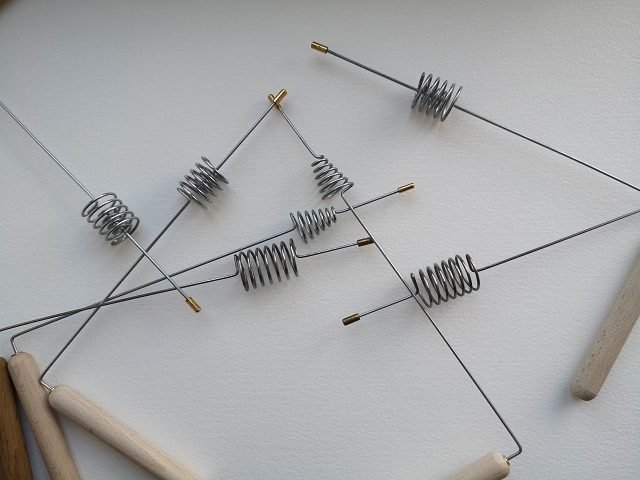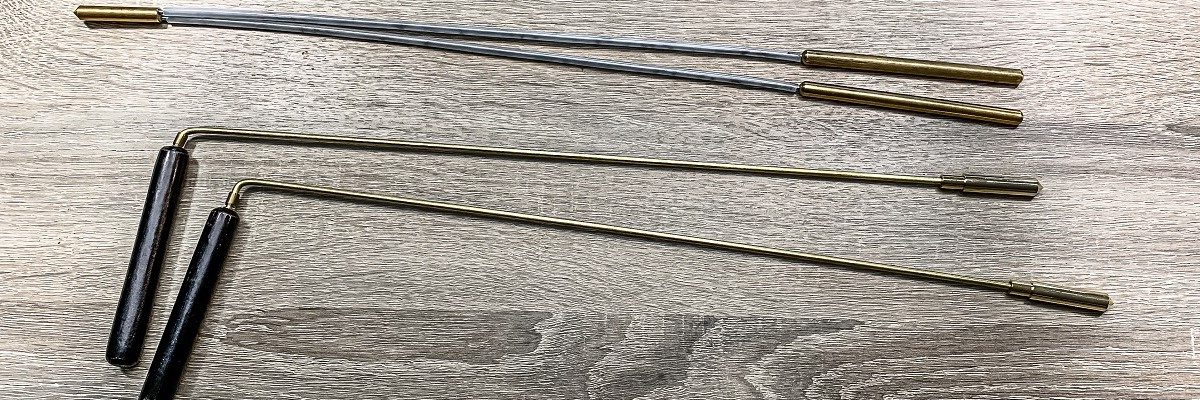How Do Dowsing Rods Work?: You’ve likely seen dowsing rods in old movies, but have you ever wondered if they really work? You’re about to discover the history, science, and myths behind these intriguing tools. We’ll delve into the materials used and the process of using dowsing rods. Don’t worry, we’ll also tackle the big question: are they truly effective? Let’s unravel this mystery together.
The History of Dowsing Rods
You’re probably unaware that dowsing rods have a rich history, dating back thousands of years. They’re not just tools for water diviners and ghost hunters; they’ve been utilized by various cultures across time, from ancient civilizations to modern societies.
It’s believed that dowsing rods were first used in ancient Egypt, around 4000 B.C. This evidence is based on artwork found in tombs depicting people holding forked sticks, which scholars suggest were used for dowsing. The practice was later adopted by the Romans and was documented in 16th-century German literature, where it was referred to as “Wünschelrute,” the German term for dowsing.
Throughout the Middle Ages, these rods were primarily used to locate underground water sources. As civilizations expanded and the need for reliable water sources grew, so did the practice of dowsing. It was in the 19th century that dowsing began to take on a more mystical quality, with some practitioners claiming they could locate not just water, but also minerals, lost objects, and even missing people.
In the 20th century, dowsing rods have been used in a variety of contexts, from finding water in arid regions to locating unmarked graves. Despite skepticism from the scientific community, many people continue to believe in their efficacy.
The Science Behind Dowsing Rods
Let’s delve into the scientific principles that might explain these intriguing tools. You might be wondering how dowsing rods, simple L-shaped metal rods, can supposedly detect hidden substances or energies. While many skeptics argue it’s a pseudoscience, others vouch for its effectiveness. As of now, science doesn’t have concrete explanations, but let’s look at three possible theories.
- Ideomotor Phenomenon: This psychological theory suggests you’re unknowingly moving the rods yourself. According to this principle, your subconscious mind influences your physical actions, causing the rods to move in response to your thoughts or expectations. It’s not the rods detecting something, but your own mind influencing your hands to manipulate the rods.
- Magnetism: Some proponents suggest that dowsing rods might react to magnetic fields. The theory is that substances like water or certain minerals can generate magnetic fields which the rods can detect. However, this hasn’t been conclusively proven in controlled experiments.
- Supernatural Explanations: A number of dowsers attribute their success to spiritual or mystical forces. While these explanations might not have a basis in recognized scientific principles, they’re an important part of understanding why some people believe in dowsing.

The Materials Used in Dowsing Rods
In your exploration of this fascinating subject, it’s worth noting that the materials used to make these intriguing tools can vary greatly. Dowsing rods, traditionally known as divining rods, can be made from a variety of materials. The most commonly used materials are copper and brass, but you’ll also find rods made of wood, particularly hazel or willow.
The choice of material isn’t random. It’s believed that certain materials, like copper and brass, can better conduct the supposed energies or magnetic fields that dowsing rods are thought to detect. Indeed, you’ll often find that professional dowser’s rods are made of these materials, reinforcing this belief.
Wood, on the other hand, has a long history in folklore and mythology. Hazel and willow, in particular, are linked with divination and water finding. Therefore, rods made of these materials aren’t just practical, they’re also rich in symbolism.
Now, does the choice of material affect the rods’ effectiveness? The evidence is inconclusive. Scientific studies haven’t found a consistent correlation between the material of the rod and its ability to locate water or other hidden objects. It’s also worth noting that the success of dowsing is generally inconsistent, regardless of the rod’s material.
In the end, the choice of material seems to be more about personal preference and belief than empirical evidence. Whether you’re a skeptic or a believer, understanding the rationale behind these choices can give you a deeper insight into the world of dowsing.
The Process of Using Dowsing Rods
When it comes to using these intriguing tools, it’s all about tuning into your own intuitive senses. Dowsing rods are a powerful tool, but they’re not magic. They require a degree of skill and understanding from the user, and that’s where you come in. Your role is to channel your energy, thoughts, and intentions into the rods and allow them to guide you based on your internal cues.
Let’s break down the process of using dowsing rods into three key steps:
- Preparation: Begin by holding the rods at a comfortable distance apart. Your mind should be clear, open, and focused. It’s important to approach the process with a specific question or objective in mind.
- Interrogation: Ask your question aloud or in your mind. Remember, the rods are an extension of your intuitive senses, so it’s crucial to be clear and direct with your intentions.
- Interpretation: Pay attention to the movement of the rods. They might cross, diverge, or sway depending on the answers they’re providing. Practice and experience will enable you to understand these movements better.
There’s a wealth of evidence suggesting that dowsing rods work based on the ideomotor effect, where your subconscious mind influences your physical reactions without you realizing it. This means the rods are essentially amplifying your own intuition, providing a physical manifestation of your subconscious thoughts.
Debunking Myths About Dowsing Rods
You’ve probably heard a few myths about these mystical tools that need clearing up. Let’s analyze the most common ones and discover the truth about dowsing rods.
The first myth is that dowsing rods are supernatural or magical. It’s a common belief, but it lacks scientific evidence. Dowsing rods are merely tools, and their effectiveness depends on the user’s ability to interpret the rods’ movements. The rods themselves don’t have inherent mystical properties. They’re typically made of metal or wood, materials that don’t possess supernatural abilities.
The second myth is that dowsing rods can locate anything and everything. While dowsers have claimed to find everything from water to precious metals and even lost items, comprehensive studies have shown that dowsing is no more effective than random chance when it comes to locating such items. In fact, a number of controlled experiments have indicated no significant difference in success rates between dowsers and non-dowsers.
Lastly, there’s the myth that anyone can dowse. While it’s true that dowsing isn’t a skill that requires special training or abilities, it does require a certain level of concentration and interpretation. Not everyone can pick up a pair of dowsing rods and immediately find what they’re looking for. It takes time and practice to understand the subtle movements of the rods and what they might be indicating.
All in all, it’s important to approach dowsing rods with an open mind but also a healthy dose of skepticism. They can be useful tools, but they’re not magical or infallible.

The Effectiveness of Dowsing Rods
Let’s delve into how effective these mystical tools really are, shall we? You’ve probably heard all sorts of stories about dowsing rods, from finding water to discovering lost items. It’s a practice that’s been around for centuries, but how much truth is there to the effectiveness of these rods?
To assess this, we’ll look at three main areas:
- Scientific Testing: Dowsing rods have been tested under controlled conditions by several scientific bodies, including the U.S. Geological Survey. Surprisingly, these tests revealed no better than chance results when it comes to finding water or minerals. So, from a strictly scientific perspective, they don’t seem to be effective.
- Anecdotal Evidence: On the other hand, many dowsers swear by their rods, claiming numerous successful finds. These personal experiences, while not scientifically validated, can’t be wholly dismissed. However, it’s worth noting these successes could be attributed to chance or knowledge of the local geography rather than the rods themselves.
- Psychological Factors: The ideomotor effect, where your subconscious mind can make tiny, involuntary movements without you realizing, could be at play. You might unknowingly move the rods based on subtle cues or pre-existing knowledge, thereby creating the illusion of their effectiveness.
Frequently Asked Questions
What Are the Different Types of Dowsing Rods Available in the Market?
There’s a variety of dowsing rods you can find on the market. You’ve got the traditional L-rods, often made of metal and shaped like an ‘L’. Then there’s the Y-rods, typically fashioned from wood or plastic. Pendulum rods are another type, commonly used for map dowsing. Lastly, there are bobber rods, which can spring in response to certain energies. Each type has its own unique uses and specialties, depending on what you’re looking for.
What Are the Potential Risks or Dangers of Using Dowsing Rods?
When you’re using dowsing rods, you should be aware of potential risks. For instance, you could wrongly interpret signals and make incorrect decisions. There’s also a risk of physical injury if you’re not careful while walking and focusing on the rods. Plus, they’re not scientifically proven to find water, minerals, or anything else. Therefore, relying on them for serious pursuits like water dowsing could lead to significant financial loss or wasted effort.
Can Anyone Learn to Use Dowsing Rods or Does It Require Special Skills or Abilities?
Sure, anyone can learn to use dowsing rods. It doesn’t require special skills or abilities. You’ll mainly need patience and an open mind. The rods are simply tools that respond to your body’s subtle reactions. Some believe they’re tuning into energy fields or water sources, but there’s no scientific evidence to back this. Practice is key. Over time, you’ll get a feel for the rods’ responses and can interpret them more accurately.
Are There Any Legal or Ethical Issues Associated With the Use of Dowsing Rods?
Regarding legal or ethical issues with dowsing rods, there’s generally no legal restriction on their use. However, ethics come into play if they’re used to deceive or exploit. For instance, if you’re claiming to find water, minerals, or lost items without any proven ability, it’s unethical. Similarly, it’s crucial to obtain permission before dowsing on private property to avoid trespassing issues. Always use dowsing rods responsibly and with respect for others’ rights and beliefs.
Can Dowsing Rods Be Used for Purposes Other Than Water Divination?
You’re not limited to water divination with dowsing rods. They’re symbols, tools of intuition, and can be used to seek out more than just water. People claim they’ve found missing objects and even detected energy fields. However, it’s important to remember that there’s no scientific evidence supporting these claims. The effectiveness relies heavily on the dowser’s skill and belief. It’s a fascinating topic, but don’t be fooled by baseless claims.

Conclusion
In essence, dowsing rods are like keys to a hidden world, unveiling what the naked eye cannot see. Despite the lure of mystery, science doesn’t provide a solid backing for their effectiveness. They’re crafted from simple materials and used with basic techniques. While they hold historical significance, many myths have been debunked. The effectiveness of dowsing rods, therefore, largely hinges on personal belief and interpretation, making it a fascinating, though often disputed, tool.

